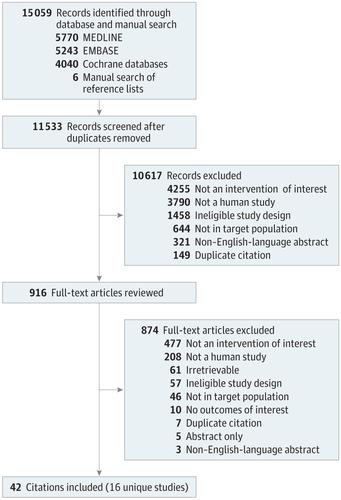Our official English website, www.x-mol.net, welcomes your
feedback! (Note: you will need to create a separate account there.)
Association of Inhaled Corticosteroids and Long-Acting β-Agonists as Controller and Quick Relief Therapy With Exacerbations and Symptom Control in Persistent Asthma
JAMA ( IF 63.1 ) Pub Date : 2018-04-10 , DOI: 10.1001/jama.2018.2769 Diana M. Sobieraj 1 , Erin R. Weeda 1 , Elaine Nguyen 1 , Craig I. Coleman 1 , C. Michael White 1 , Stephen C. Lazarus 2 , Kathryn V. Blake 3 , Jason E. Lang 4 , William L. Baker 1
JAMA ( IF 63.1 ) Pub Date : 2018-04-10 , DOI: 10.1001/jama.2018.2769 Diana M. Sobieraj 1 , Erin R. Weeda 1 , Elaine Nguyen 1 , Craig I. Coleman 1 , C. Michael White 1 , Stephen C. Lazarus 2 , Kathryn V. Blake 3 , Jason E. Lang 4 , William L. Baker 1
Affiliation

|
Importance Combined use of inhaled corticosteroids and long-acting &bgr;-agonists (LABAs) as the controller and the quick relief therapy termed single maintenance and reliever therapy (SMART) is a potential therapeutic regimen for the management of persistent asthma. Objective To conduct a systematic review and meta-analysis of the effects of SMART in patients with persistent asthma. Data Sources and Study Selection The databases of MEDLINE via OVID, EMBASE, the Cochrane Central Register of Controlled Trials, and the Cochrane Database of Systematic Reviews were searched from database inception through August 2016 and updated through November 28, 2017. Two reviewers selected randomized clinical trials or observational studies evaluating SMART vs inhaled corticosteroids with or without a LABA used as the controller therapy and short-acting &bgr;-agonists as the relief therapy for patients aged 5 years or older with persistent asthma and reporting on an outcome of interest. Data Extraction and Synthesis Meta-analyses were conducted using a random-effects model to calculate risk ratios (RRs), risk differences (RDs), and mean differences with corresponding 95% CIs. Citation screening, data abstraction, risk assessment, and strength of evidence grading were completed by 2 independent reviewers. Main Outcomes and Measures Asthma exacerbations. Results The analyses included 16 randomized clinical trials (N = 22 748 patients), 15 of which evaluated SMART as a combination therapy with budesonide and formoterol in a dry-powder inhaler. Among patients aged 12 years or older (n = 22 524; mean age, 42 years; 14 634 [65%] were female), SMART was associated with a reduced risk of asthma exacerbations compared with the same dose of inhaled corticosteroids and LABA as the controller therapy (RR, 0.68 [95% CI, 0.58 to 0.80]; RD, −6.4% [95% CI, −10.2% to −2.6%]) and a higher dose of inhaled corticosteroids and LABA as the controller therapy (RR, 0.77 [95% CI, 0.60 to 0.98]; RD, −2.8% [95% CI, −5.2% to −0.3%]). Similar results were seen when SMART was compared with inhaled corticosteroids alone as the controller therapy. Among patients aged 4 to 11 years (n = 341; median age, 8 [range, 4-11] years; 69 [31%] were female), SMART was associated with a reduced risk of asthma exacerbations compared with a higher dose of inhaled corticosteroids as the controller therapy (RR, 0.55 [95% CI, 0.32 to 0.94]; RD, −12.0% [95% CI, −22.5% to −1.5%]) or the same dose of inhaled corticosteroids and LABA as the controller therapy (RR, 0.38 [95% CI, 0.23 to 0.63]; RD, −23.2% [95% CI, −33.6% to −12.1%]). Conclusions and Relevance In this meta-analysis of patients with persistent asthma, the use of single maintenance and reliever therapy compared with inhaled corticosteroids as the controller therapy (with or without a long-acting &bgr;-agonist) and short-acting &bgr;-agonists as the relief therapy was associated with a lower risk of asthma exacerbations. Evidence for patients aged 4 to 11 years was limited.
中文翻译:

吸入性皮质类固醇和长效 β-激动剂作为控制器和快速缓解疗法与持续性哮喘恶化和症状控制的关联
重要性 联合使用吸入性皮质类固醇和长效β-激动剂 (LABA) 作为控制剂以及称为单一维持和缓解疗法 (SMART) 的快速缓解疗法是治疗持续性哮喘的潜在治疗方案。目的对SMART对持续性哮喘患者的影响进行系统评价和荟萃分析。数据来源和研究选择 MEDLINE 数据库通过 OVID、EMBASE、Cochrane 对照试验中央登记库和 Cochrane 系统评价数据库进行了搜索,从数据库开始到 2016 年 8 月并更新到 2017 年 11 月 28 日。两名评价者选择了随机临床评估 SMART 与吸入皮质类固醇的试验或观察性研究,使用或不使用 LABA 作为控制疗法和短效 & bgr;-激动剂作为 5 岁或以上患有持续性哮喘并报告感兴趣的结果的患者的缓解疗法。使用随机效应模型进行数据提取和综合 Meta 分析,以计算风险比 (RR)、风险差异 (RD) 和与相应 95% CI 的平均差异。引文筛选、数据提取、风险评估和证据强度分级由 2 名独立审查员完成。主要结果和措施 哮喘恶化。结果 分析包括 16 项随机临床试验(N = 22 748 名患者),其中 15 项评估了 SMART 作为干粉吸入器中布地奈德和福莫特罗的联合疗法。在 12 岁或以上的患者中(n = 22 524;平均年龄,42 岁;14 634 [65%] 为女性),与相同剂量的吸入性皮质类固醇和 LABA 作为对照疗法相比,SMART 与哮喘恶化风险降低相关(RR,0.68 [95% CI,0.58 至 0.80];RD,-6.4% [95% CI,-10.2 % 至 -2.6%])和更高剂量的吸入性皮质类固醇和 LABA 作为控制疗法(RR,0.77 [95% CI,0.60 至 0.98];RD,-2.8% [95% CI,-5.2% 至 -0.3 %])。当将 SMART 与单独吸入皮质类固醇作为控制疗法进行比较时,也看到了类似的结果。在 4 至 11 岁的患者中(n = 341;中位年龄,8 [范围,4-11] 岁;69 [31%] 是女性),与更高剂量的 SMART 相比,SMART 与哮喘恶化风险降低相关。吸入皮质类固醇作为控制疗法(RR,0.55 [95% CI,0.32 至 0.94];RD,-12.0% [95% CI,-22.5% 至 -1。5%]) 或相同剂量的吸入皮质类固醇和 LABA 作为对照治疗(RR,0.38 [95% CI,0.23 至 0.63];RD,-23.2% [95% CI,-33.6% 至 -12.1%]) . 结论和相关性 在这项针对持续性哮喘患者的荟萃分析中,使用单一维持和缓解疗法与作为控制疗法(有或没有长效 β-激动剂)和短效 β- 的吸入性皮质类固醇进行比较激动剂作为缓解疗法与较低的哮喘恶化风险相关。4 至 11 岁患者的证据有限。与作为控制疗法(使用或不使用长效β-激动剂)和使用短效β-激动剂作为缓解疗法的吸入皮质类固醇相比,使用单一维持和缓解疗法与哮喘恶化风险较低相关. 4 至 11 岁患者的证据有限。与作为控制疗法(使用或不使用长效β-激动剂)和使用短效β-激动剂作为缓解疗法的吸入皮质类固醇相比,使用单一维持和缓解疗法与哮喘恶化风险较低相关. 4 至 11 岁患者的证据有限。
更新日期:2018-04-10
中文翻译:

吸入性皮质类固醇和长效 β-激动剂作为控制器和快速缓解疗法与持续性哮喘恶化和症状控制的关联
重要性 联合使用吸入性皮质类固醇和长效β-激动剂 (LABA) 作为控制剂以及称为单一维持和缓解疗法 (SMART) 的快速缓解疗法是治疗持续性哮喘的潜在治疗方案。目的对SMART对持续性哮喘患者的影响进行系统评价和荟萃分析。数据来源和研究选择 MEDLINE 数据库通过 OVID、EMBASE、Cochrane 对照试验中央登记库和 Cochrane 系统评价数据库进行了搜索,从数据库开始到 2016 年 8 月并更新到 2017 年 11 月 28 日。两名评价者选择了随机临床评估 SMART 与吸入皮质类固醇的试验或观察性研究,使用或不使用 LABA 作为控制疗法和短效 & bgr;-激动剂作为 5 岁或以上患有持续性哮喘并报告感兴趣的结果的患者的缓解疗法。使用随机效应模型进行数据提取和综合 Meta 分析,以计算风险比 (RR)、风险差异 (RD) 和与相应 95% CI 的平均差异。引文筛选、数据提取、风险评估和证据强度分级由 2 名独立审查员完成。主要结果和措施 哮喘恶化。结果 分析包括 16 项随机临床试验(N = 22 748 名患者),其中 15 项评估了 SMART 作为干粉吸入器中布地奈德和福莫特罗的联合疗法。在 12 岁或以上的患者中(n = 22 524;平均年龄,42 岁;14 634 [65%] 为女性),与相同剂量的吸入性皮质类固醇和 LABA 作为对照疗法相比,SMART 与哮喘恶化风险降低相关(RR,0.68 [95% CI,0.58 至 0.80];RD,-6.4% [95% CI,-10.2 % 至 -2.6%])和更高剂量的吸入性皮质类固醇和 LABA 作为控制疗法(RR,0.77 [95% CI,0.60 至 0.98];RD,-2.8% [95% CI,-5.2% 至 -0.3 %])。当将 SMART 与单独吸入皮质类固醇作为控制疗法进行比较时,也看到了类似的结果。在 4 至 11 岁的患者中(n = 341;中位年龄,8 [范围,4-11] 岁;69 [31%] 是女性),与更高剂量的 SMART 相比,SMART 与哮喘恶化风险降低相关。吸入皮质类固醇作为控制疗法(RR,0.55 [95% CI,0.32 至 0.94];RD,-12.0% [95% CI,-22.5% 至 -1。5%]) 或相同剂量的吸入皮质类固醇和 LABA 作为对照治疗(RR,0.38 [95% CI,0.23 至 0.63];RD,-23.2% [95% CI,-33.6% 至 -12.1%]) . 结论和相关性 在这项针对持续性哮喘患者的荟萃分析中,使用单一维持和缓解疗法与作为控制疗法(有或没有长效 β-激动剂)和短效 β- 的吸入性皮质类固醇进行比较激动剂作为缓解疗法与较低的哮喘恶化风险相关。4 至 11 岁患者的证据有限。与作为控制疗法(使用或不使用长效β-激动剂)和使用短效β-激动剂作为缓解疗法的吸入皮质类固醇相比,使用单一维持和缓解疗法与哮喘恶化风险较低相关. 4 至 11 岁患者的证据有限。与作为控制疗法(使用或不使用长效β-激动剂)和使用短效β-激动剂作为缓解疗法的吸入皮质类固醇相比,使用单一维持和缓解疗法与哮喘恶化风险较低相关. 4 至 11 岁患者的证据有限。











































 京公网安备 11010802027423号
京公网安备 11010802027423号